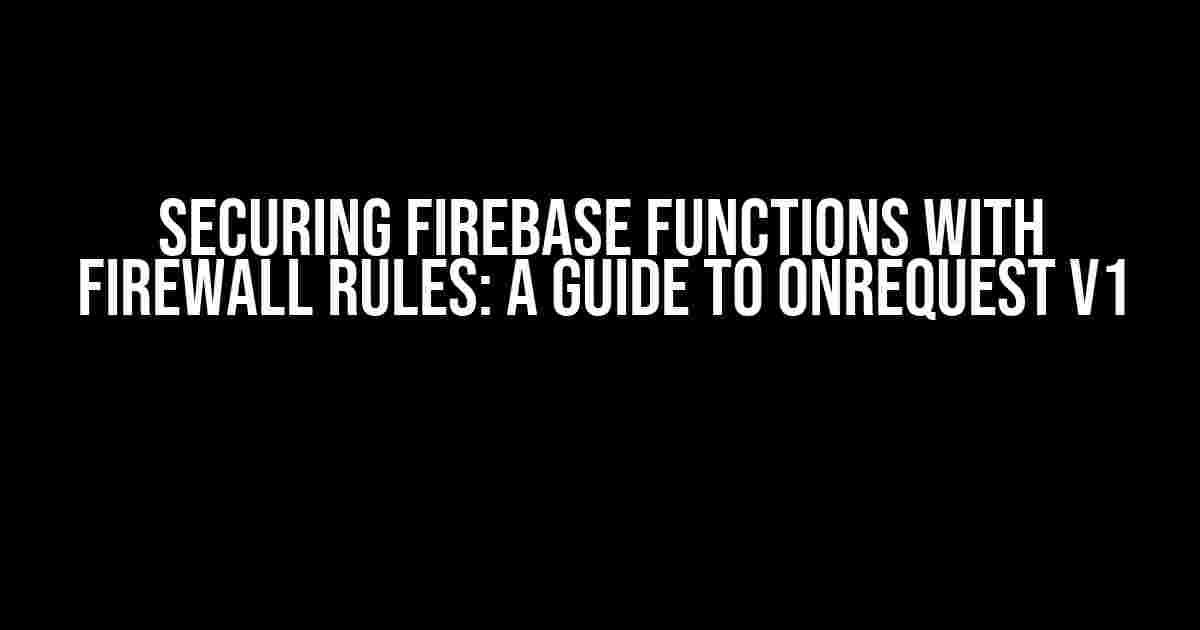Firebase Functions provide a powerful way to run server-side code, but they can also introduce security risks if not properly secured. One crucial aspect of securing Firebase Functions is configuring firewall rules to control incoming traffic. In this article, we’ll explore how to create a firewall rule against Firebase Functions, specifically focusing on onRequest v1.
Understanding Firebase Firewall Rules
Firebase firewall rules allow you to filter incoming traffic to your Firebase project, including Functions. These rules are composed of two main components: a source IP range and a target. The source IP range specifies the IP addresses or ranges that are allowed to access your Firebase project, while the target defines the specific resources or Functions to which the rule applies.
Creating a Firewall Rule against Firebase onRequest v1
To create a firewall rule against Firebase onRequest v1, follow these steps:
-
Navigate to the Firebase Console and select your project.
-
Click on the “Navigation menu” (three horizontal lines in the top left corner) and select “VPC Network” under the “Network” section.
-
Click on “Firewall rules” and then click on “Create firewall rule”.
-
In the “Create firewall rule” page, enter a name and description for your rule.
-
In the “Targets” section, select “Cloud Functions” as the target type and choose the specific onRequest v1 Function you want to secure.
-
In the “Source IP ranges” section, enter the IP ranges or addresses that you want to allow access to your Function. You can enter a single IP address, a range of IP addresses (e.g., 192.0.2.0/24), or a list of IP addresses separated by commas.
-
Click “Create” to create the firewall rule.
Example Firewall Rule Configuration
Here’s an example of a firewall rule configuration that allows access to an onRequest v1 Function from a specific IP address range:
- Rule name: Allow access to onRequest v1 Function from corporate network
- Description: Allows access to onRequest v1 Function from corporate network IP range
- Targets: Cloud Functions, onRequest v1 Function (select the specific Function)
- Source IP ranges: 192.0.2.0/24
Best Practices for Firebase Firewall Rules
To ensure the security of your Firebase Functions, follow these best practices when creating firewall rules:
- Always specify a target: Define the specific Function or resource that the rule applies to, rather than applying the rule to all Functions.
- Be specific with source IP ranges: Only allow access from specific IP addresses or ranges, rather than allowing traffic from entire countries or regions.
- Use firewall rules in conjunction with other security measures: Implement additional security measures, such as authentication and authorization, to further secure your Firebase Functions.
By following these guidelines and creating a firewall rule against Firebase onRequest v1, you can effectively secure your Functions and protect your Firebase project from unauthorized access.
Here is the FAQ on “Firewall rule against Firebase function, specifically Firebase onRequest v1”:
Frequently Asked Question
Stuck with Firebase Functions and Firestore security rules? We’ve got you covered! Here are some answers to frequently asked questions about firewall rules and Firebase onRequest v1.
What is the purpose of a firewall rule against Firebase functions?
A firewall rule against Firebase functions is used to control incoming traffic to your Cloud Function, ensuring that only authorized requests are executed. This prevents unauthorized access, reduces the risk of attacks, and protects your function from abuse.
How does Firebase onRequest v1 handle firewall rules?
Firebase onRequest v1 uses the `request.headers` object to evaluate firewall rules. When a request is made to your Firebase function, the `request.headers` object is checked against the defined firewall rules. If the request meets the rule conditions, the function is executed; otherwise, it’s blocked.
What are some common firewall rule patterns for Firebase onRequest v1?
Common firewall rule patterns for Firebase onRequest v1 include IP-based restrictions (e.g., only allow requests from specific IP addresses), HTTP method restrictions (e.g., only allow GET or POST requests), and Header-based restrictions (e.g., only allow requests with specific headers). You can also combine these patterns to create more complex rules.
Can I use Firebase Security Rules to restrict access to my Firebase function?
No, Firebase Security Rules only apply to Firestore, Realtime Database, and Storage. To restrict access to your Firebase function, you need to use firewall rules, which are applied at the Cloud Function level.
How do I test my firewall rules against my Firebase function?
You can test your firewall rules by sending requests to your Firebase function using tools like `curl` or Postman. You can also use the Firebase CLI to test your function locally and see how the firewall rules are applied.


